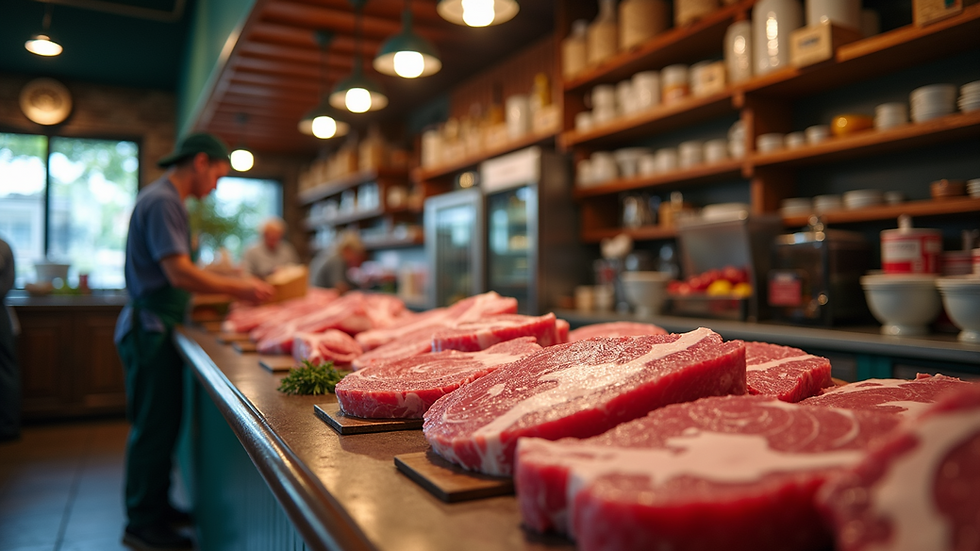A Guide to Australian Butchery Practices and Traditions
- Team @ Ezy Click Answers
- Sep 15
- 4 min read
Australia has a rich history of butchery that reflects its diverse culture and agricultural heritage. The butcher shop is more than just a place to buy meat; it is a hub of tradition, skill, and community connection. This guide explores the unique practices and customs that define Australian butchery, offering insights into how these traditions continue to evolve in modern times.
The Role of the Butcher Shop in Australian Communities
Butcher shops in Australia have long been a cornerstone of local communities. Unlike large supermarkets, these shops provide personalized service and expert advice on meat selection and preparation. Many Australians prefer buying from a local butcher because of the quality and freshness of the products.
In a typical butcher shop, you will find a wide range of meats including beef, lamb, pork, and poultry. Butchers often source their meat from local farms, ensuring traceability and supporting regional producers. This connection to local agriculture is a key aspect of Australian butchery traditions.
Key features of Australian butcher shops:
Custom cuts tailored to customer preferences
Knowledgeable staff offering cooking tips
Specialty products like sausages, marinades, and cured meats
Emphasis on sustainable and ethical sourcing

Understanding Butcher Shop Practices in Australia
Australian butchery practices combine traditional skills with modern technology. Butchers undergo extensive training to master the art of meat cutting, ensuring minimal waste and maximum flavor. The process starts with selecting the right carcass, followed by precise cutting techniques that highlight the best parts of the meat.
One distinctive practice is the aging of beef, which enhances tenderness and flavor. Dry aging is common in many butcher shops, where beef is hung in controlled environments for several weeks. This method requires expertise to maintain hygiene and achieve the desired taste profile.
Butchers also play a vital role in educating customers about different cuts and cooking methods. For example, they might recommend slow cooking for tougher cuts like brisket or quick grilling for tender steaks. This personalized guidance helps customers make informed choices and enjoy their meals to the fullest.
For those interested in exploring more about butcher shops in Australia, butcher shop australia offers valuable resources and insights into the industry.

Why is Woolworths Closing Butchers?
In recent years, Woolworths, one of Australia's largest supermarket chains, has announced the closure of many of its in-store butcher counters. This decision has sparked discussions about the future of traditional butchery in the country.
The primary reasons behind Woolworths closing butchers include:
Cost Efficiency: Operating butcher counters requires skilled staff and specialized equipment, which increases operational costs.
Changing Consumer Habits: Many customers now prefer the convenience of pre-packaged meat or online shopping.
Supply Chain Streamlining: Centralized meat processing and packaging allow supermarkets to reduce complexity and improve consistency.
While this shift may benefit large retailers, it has raised concerns about the loss of personalized service and local meat expertise. Many consumers are turning back to independent butcher shops to experience the traditional craft and quality that supermarkets can no longer provide.
This trend highlights the importance of supporting local butchers who maintain Australia's butchery heritage and offer unique products that supermarkets cannot replicate.

Traditional Australian Butchery Techniques and Cuts
Australian butchers are known for their mastery of specific cuts that suit local tastes and cooking styles. Some traditional cuts and techniques include:
Porterhouse and Rump Steaks: Popular for grilling and barbecues, these cuts are prized for their tenderness and flavor.
Lamb Shoulder and Leg: Often slow-cooked or roasted, lamb is a staple in Australian cuisine.
Sausage Making: Many butcher shops produce their own sausages using traditional recipes, incorporating native spices and herbs.
Offal Preparation: Organ meats like liver and kidney are commonly used in traditional dishes and require careful handling.
Butchers also use specialized knives and saws to ensure precision. The skillful separation of muscle groups and trimming of fat are essential to delivering high-quality meat that meets customer expectations.
For home cooks, understanding these cuts and techniques can enhance meal preparation and enjoyment. Butchers often provide cooking advice, recipes, and even demonstrations to help customers make the most of their purchases.
The Future of Butchery in Australia
Despite challenges like supermarket competition and changing consumer preferences, the future of Australian butchery remains promising. There is a growing movement towards sustainable and ethical meat consumption, which benefits local butchers who prioritize quality and transparency.
Innovations such as online ordering, home delivery, and specialty meat products are helping butcher shops adapt to modern demands. Additionally, the resurgence of interest in traditional cooking methods and artisanal foods supports the continued relevance of skilled butchers.
Consumers are encouraged to:
Support local butcher shops for fresher, higher-quality meat
Explore lesser-known cuts to reduce waste and discover new flavors
Ask butchers for advice on cooking and storage
Consider the environmental impact of meat choices
By embracing both tradition and innovation, Australian butcher shops can continue to thrive and serve their communities for generations to come.
This guide has provided an overview of the rich traditions and evolving practices within Australian butchery. Whether you are a seasoned cook or new to meat preparation, understanding these customs can deepen your appreciation for the craft and quality behind every cut. For those seeking authentic experiences and expert advice, visiting a local butcher shop remains the best way to connect with Australia's culinary heritage.



Comments